5 Worst Meats for Your Cholesterol, Says Dietitian
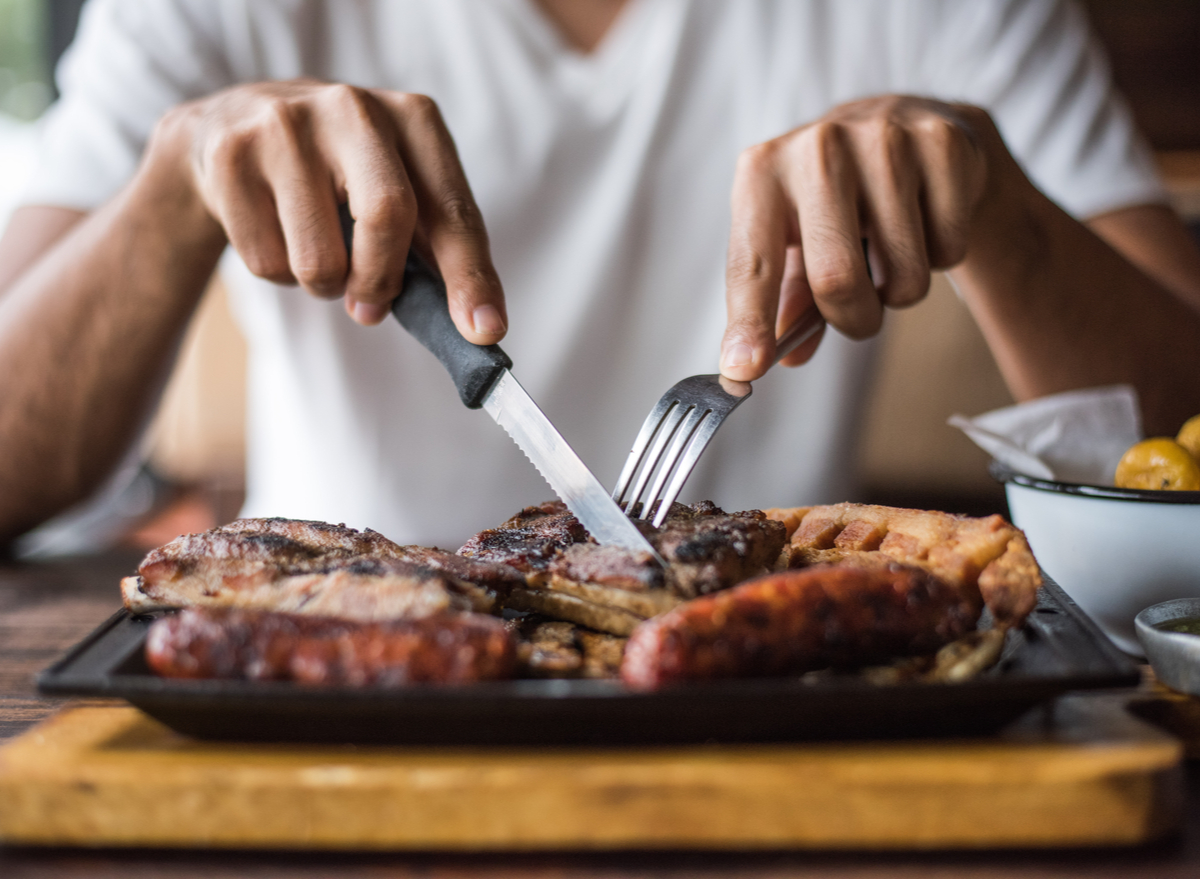
High cholesterol is a major contributing factor to heart disease, which remains the number one leading cause of death. Cholesterol, along with plaque and other fatty deposits, on the inside of the arterial walls of the heart, can build up to the point of causing blood clots. These blood clots can worsen and result in a heart attack while blood clots in the brain or leading to the brain may cause a stroke. This is concerning; however, in most cases, high cholesterol levels can be prevented and controlled through a healthy diet, exercise, avoiding smoking, limiting alcohol intake, and managing weight.
Most health providers recommend striving for total blood cholesterol levels below 200mg/dL (milligrams per deciliter) for ultimate protection against cardiovascular issues. Contrary to what one may think, dietary cholesterol does not have as detrimental of an impact on blood cholesterol levels as saturated and trans fat. Evidence now points to the type of fat, not the amount of fat, as being the most impactful to heart disease risk. In fact, significant FDA labeling revisions in 2016 increased the Daily Value (DV) recommendation for total fat from 65 grams a day to 78 grams a day.
Try to keep saturated fat intake at under 10 percent of total calories (for example, this means up to 22 grams of saturated fat for someone following a 2,000-calorie diet) and trans fat intake as sparse as possible. Thankfully, partially hydrogenated oils (PHOs), the most abundant source of trans fat previously in the food supply, have not been permitted as an additive in food following the 2015 FDA ruling that PHOs are not considered GRAS (Generally Recognized as Safe). However, small amounts of trans fat naturally occur in some animal products like beef, lamb, milk, and butter.
Read on for the five of the top meats to eliminate or reduce from your diet to help bring down your cholesterol numbers, and for more, don’t miss 5 Worst Eating Habits Secretly Raising Your Cholesterol, Say Dietitians.
Bacon
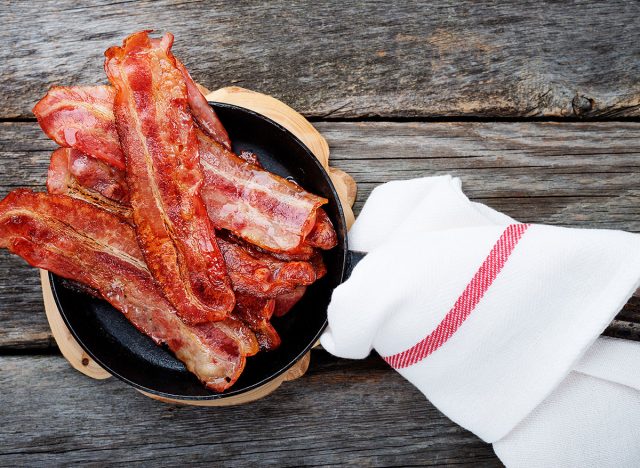
Whether it be at breakfast alongside eggs and a biscuit, wrapped around vegetables like asparagus, or nestled between a sesame seed bun, hamburger patty, and cheese, bacon seems to slither its way into many Americanized dishes. It offers a crispy layer of savoriness that may help pull a meal together. Unfortunately, it isn’t pulling your health together. The total calories from saturated fat in most bacon products (about 27 calories per two-slice serving) is more than the calories of protein (about 22 calories per two-slice serving)!
Steak
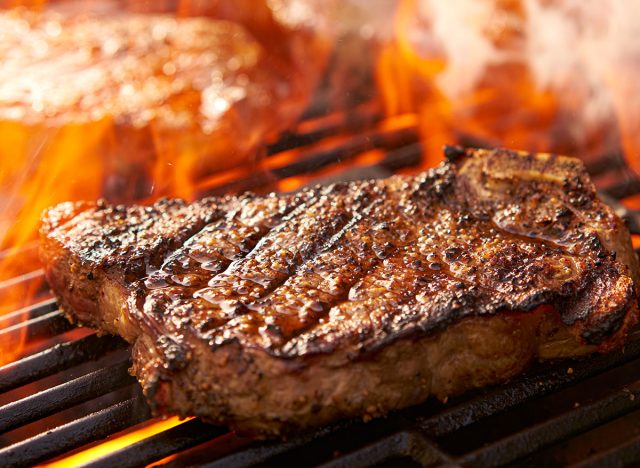
It’s a good idea to familiarize yourself with the nutrition associated with various cuts of steak, as they can vary widely. Although leaner grinds of bison may be processed to reduce fat, and therefore heralded as a better-for-you meat, a bison ribeye steak makes a cringe-worthy contribution to your fat intake. It contains 11 grams of saturated fat and one gram of trans fat per four-ounce serving without being trimmed.
A filet mignon tenderloin steak has a shockingly comparative 10 grams of saturated per four-ounce serving.
The porterhouse steak, sourced from the loin of a cow, comes in close to previous potential cholesterol-raising contenders at nine grams of saturated fat (and 290 calories!) per four-ounce serving.
Lamb
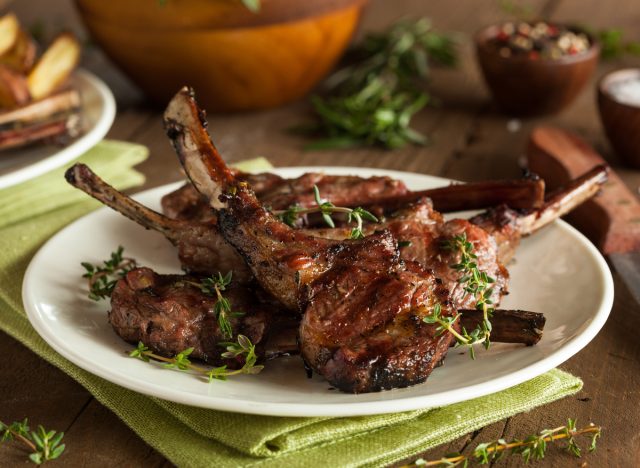
Red meat is often used interchangeably with the word “beef,” however, meats like lamb, goat, bison, and pork are also red meats, as they contain a significant amount of myoglobin, making them appear red. Most lamb loin chops provide about 11 grams of saturated fat per four-ounce serving, while lamb shoulder chops come in at around nine grams of saturated fat per four-ounce serving.
Red meats should be consumed no more than once per week, and consider further limiting intake if your cholesterol is out of range or you have a family history of high cholesterol or cardiovascular disease.
Ribs
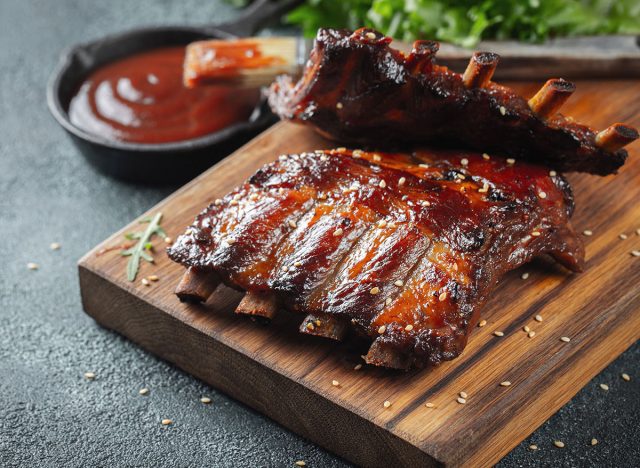
It may come as no surprise that ribs make this list. Ribs usually have visible fat seen as marbling throughout the meat and can be tender enough when cooked to be pulled off the bone. The bad news is a cut of beef center cut back ribs, beef flank style ribs, and beef bone-in short ribs contain 13 grams of saturated fat per four-ounce serving.
If you ordered ribs at a restaurant, try to split them with a friend (or two!) and load up on a side of veggies. Fiber intake is associated with better cholesterol control and ribs have zero fiber, while many vegetables contain several grams of fiber per serving.
Sausage
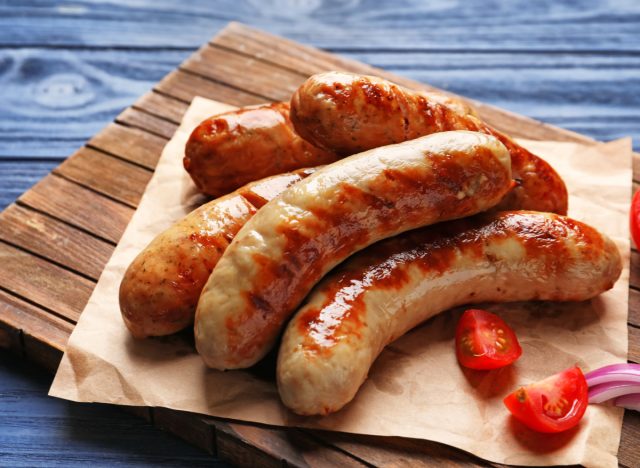
Intake of processed meats like sausage can make stabilizing your cholesterol levels even more difficult. Consider that most smoked sausage links contain 6 grams of saturated fat per two-ounce serving (and 350 to 500 milligrams of sodium—we don’t want to shoot up blood pressure too!) and a sausage kielbasa chimes in at 5 grams of saturated fat per two-ounce serving.
To keep cholesterol levels in check, try out less fattening plant-based sausages such as Simple Truth Meatless Breakfast Patties (0.5 grams saturated fat per two-ounce serving) or Simple Truth Plant-Based Meatless Kielbasa Sausage (1.5 grams saturated fat for a whole sausage weighing about 3.3 ounces).









